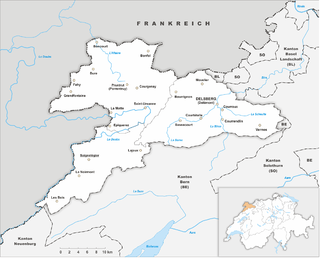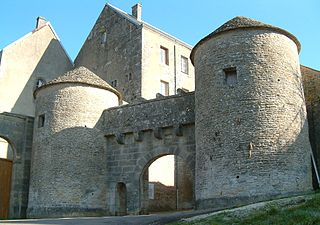
The Abbey of Saint Gall is a dissolved abbey (747–1805) in a Catholic religious complex in the city of St. Gallen in Switzerland. The Carolingian-era monastery existed from 719, founded by Saint Othmar on the spot where Saint Gall had erected his hermitage. It became an independent principality between 9th and 13th centuries, and was for many centuries one of the chief Benedictine abbeys in Europe. The library of the Abbey is one of the oldest monastic libraries in the world.

Jura is a département in the Bourgogne-Franche-Comté region in Eastern France. Named after the Jura Mountains, its prefecture is Lons-le-Saunier. Its subprefectures are Dole and Saint-Claude. In 2019, Jura had a population of 259,199. Its INSEE code is 39. It has a short portion of the border of Switzerland.

The Republic and Canton of Jura, less formally the Canton of Jura or Canton Jura, is the newest of the 26 Swiss cantons, located in the northwestern part of Switzerland. The capital is Delémont. It shares borders with the canton of Basel-Landschaft, the canton of Bern, the canton of Neuchatel, the canton of Solothurn, and the French régions of Bourgogne-Franche-Comté and Grand Est.

Gall according to hagiographic tradition was a disciple and one of the traditional twelve companions of Columbanus on his mission from Ireland to the continent. However, he may have originally come from the border region between Lorraine and Alemannia and only met Columbanus at the monastery of Luxeuil in the Vosges. Gall is known as a representative of the Irish monastic tradition. The Abbey of Saint Gall in the city of Saint Gallen, Switzerland was built upon his original hermitage. Deicolus was the elder brother of Gall.

Delémont is the capital of the Swiss canton of Jura. The city has approximately 12,000 inhabitants as of 2013.

Flavigny-sur-Ozerain is a commune in the French department of Côte-d'Or, in Bourgogne-Franche-Comté.

Moutier is a municipality in Switzerland. Currently, the town belongs to the Jura bernois administrative district of the canton of Bern. On 28 March 2021, the population voted to secede from the canton of Bern and join the Canton of Jura; the decision however is not immediately operative and entails a lengthy process of transfer of competences between cantonal authorities.

The Doubs is a 453-kilometre (281 mi) river in far eastern France which strays into western Switzerland. It is a left-bank tributary of the Saône. It rises near Mouthe in the western Jura mountains, at 946 metres (3,104 ft) and its mouth is at Verdun-sur-le-Doubs, a village and commune in Saône-et-Loire at about 175 m (574 ft) above sea level. It is the tenth-longest river in France.
Einsiedeln is a municipality and district in the canton of Schwyz in Switzerland known for its monastery, the Benedictine Einsiedeln Abbey, established in the 10th century.

Col de la Croix is a pass in the Jura range connecting Saint-Ursanne and Courgenay, both in the canton of Jura in Switzerland.

Saint-Imier is a municipality in the Jura bernois administrative district in the canton of Bern in Switzerland. It is located in the French-speaking Bernese Jura.

The Republic of Saugeais is a self-proclaimed micronation located in eastern France, in the département of Doubs. The republic comprises the 11 municipalities of Les Alliés, Arçon, Bugny, La Chaux-de-Gilley, Gilley, Hauterive-la-Fresse, La Longeville, Montflovin, Maisons-du-Bois-Lièvremont, Ville-du-Pont, and its capital Montbenoît.

Ursicinus was an Irish missionary and hermit in the Jura region.

Montbenoît is a commune in the Doubs department in the Bourgogne-Franche-Comté region in eastern France.

Saint Germanus of Granfelden was the first abbot of Moutier-Grandval Abbey. He is venerated as a martyr saint in the Catholic and Eastern Orthodox Churches.
Romanus of Condat is a saint of the fifth century. At the age of thirty five, he decided to live as a hermit in the area of Condat. His younger brother Lupicinus followed him there. They became leaders of a community of monks that included Eugendus.

Saint Wandregisel was a Frankish courtier, monk, and abbot.

Clos du Doubs is a municipality in the district of Porrentruy in the canton of Jura in Switzerland. It was founded on January 1, 2009 by the former municipalities of Epauvillers, Epiquerez, Montenol, Montmelon, Ocourt, Saint-Ursanne and Seleute. Soubey voted not to join the merger.

Mont Terri is one of the mountains of the Jura Mountains range. It is located south of Cornol in the Canton of Jura.

St-Ursanne railway station is a railway station in the former municipality of Saint-Ursanne, now part of Clos du Doubs, in the Swiss canton of Jura. It is an intermediate stop on the standard gauge Delémont–Delle line of Swiss Federal Railways.

























